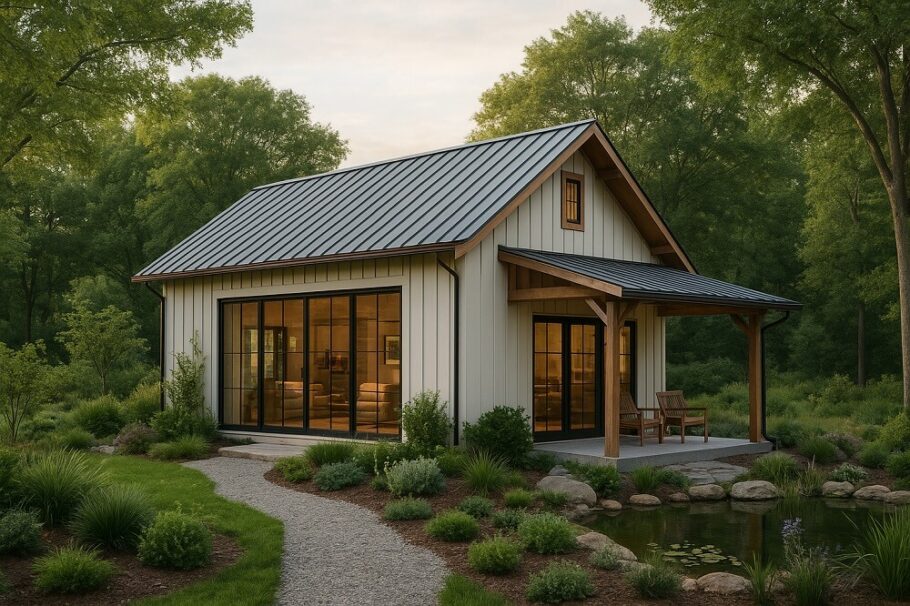When a building looks as though it has always belonged to its landscape — nestled into the slope, aligned with the sun, and shaped by the trees and terrain — it transcends mere construction. It becomes a living part of its environment. This is the philosophy behind landscape-integrated barndominium design, where architecture and nature merge to create spaces that feel both timeless and deeply personal.
Barndominiums, with their flexible steel frames and open layouts, are perfectly suited to this concept. While they began as practical metal buildings on agricultural land, they’ve evolved into a modern design canvas for those who want to live in harmony with the land. Integrating a barndominium into its site involves more than just aesthetic choices — it’s about sustainability, comfort, and respect for the natural world.
In this post, we’ll explore what it means to design a landscape-integrated barndominium, including site analysis, form generation, material selection, and strategies to make a home that seems to grow from the earth itself.
1. The Philosophy of Landscape Integration
Landscape-integrated design is rooted in the idea that buildings should respond to the environment, not dominate it. Rather than imposing a form onto the land, the architect works with natural contours, sunlight, vegetation, and views to create harmony between structure and setting.
This approach aligns perfectly with the rural character of barndominiums. Many are built on open acreage or wooded lots — places where the connection to the outdoors is a major part of the appeal. By integrating the home into the site, you emphasize the land’s existing beauty rather than covering it.
The result is a structure that looks inevitable — like it was meant to be there.
2. Site-Driven Design: Reading the Land
Before a single line is drawn, landscape-integrated design begins with listening to the site.
A detailed site analysis should include:
- Topography: Understanding slope, drainage, and elevation changes determines how to position the foundation and floor levels.
- Sun Path: Orienting the long side of a barndominium to the south (in the northern hemisphere) captures passive solar gain and natural light.
- Prevailing Winds: Positioning openings to catch or block breezes helps with natural ventilation.
- Views and Vistas: Identifying what deserves to be framed through windows or porches.
- Existing Vegetation: Mature trees can provide shade, privacy, and erosion control — and they’re often worth designing around.
This step turns the land into a collaborator. Instead of clearing and flattening the site, the barndominium design might nestle into a hillside, rise slightly above a meadow, or wrap around a cluster of old oaks.
For example, a barndominium built on sloping terrain could use a split-level design: the upper level aligns with the driveway while the lower level opens directly onto the landscape below, minimizing excavation while creating a natural flow between indoors and outdoors.
3. Foundation Choices that Respect the Land
Landscape-integrated barndominiums often move away from the standard flat slab foundation. The goal is to follow the terrain rather than fight it.
Common strategies include:
- Pier Foundations: Elevate the barndominium slightly, allowing natural drainage and vegetation to remain underneath. This is ideal for sloped or wooded sites.
- Stem Wall Foundations: Combine a concrete stem wall with fill to step the building down a slope gracefully.
- Partial Earth Integration: For hillsides, one side of the structure can be bermed (covered partially by soil) to moderate indoor temperatures and visually root the building to the ground.
When the foundation works with the terrain instead of against it, both the cost and environmental impact of earth-moving can be significantly reduced.
4. Material Selection: Borrowing from Nature
Material palette plays a crucial role in making a barndominium feel like an extension of its landscape. Natural textures, muted tones, and regionally sourced materials can make a structure blend seamlessly into its surroundings.
Common materials for landscape integration include:
- Weathering Steel (Corten): Develops a natural rust patina that complements earthy environments.
- Wood Cladding: Cedar, cypress, or thermally modified wood weathers beautifully and echoes nearby trees.
- Stone Veneer or Local Masonry: Grounding the base of the building in stone can visually anchor it to the terrain.
- Green or Living Roofs: Covered in vegetation, these reduce runoff, improve insulation, and visually merge the roofline with the natural horizon.
- Matte Finishes: Avoiding reflective metal panels helps the barndominium feel quieter and more integrated.
Choosing a restrained color palette — browns, grays, greens, and warm neutrals — can make the building’s mass recede into the landscape rather than stand apart from it.
5. Designing the Form: Shaped by Land and Light
Traditional barns are simple, gabled forms designed for function. Landscape-integrated barndominiums build on that simplicity while responding to the unique geometry of their environment.
A few strategies include:
- Low-Profile Rooflines: Lower eaves and shallow pitches reduce visual impact against the horizon.
- Asymmetrical Massing: Adjusting roof heights or extending one side to follow terrain contours makes the structure feel more natural.
- Clerestories and Transoms: Let in light without disrupting the flow of the roofline or views.
- Overhangs and Porches: Shade southern windows, frame views, and create a transition zone between indoors and outdoors.
Sunlight and shadow also play a sculptural role. Deep overhangs, recessed entries, and cantilevered decks can all interact with light in a way that makes the building appear to shift throughout the day — as if alive within its environment.
6. Outdoor-Indoor Transitions: Living with the Landscape
In a landscape-integrated barndominium, the line between indoors and outdoors should be soft and fluid.
Design elements that enhance this connection include:
- Large Operable Glazing: Sliding glass walls or folding panels dissolve boundaries and make the outdoors part of daily living.
- Covered Outdoor Rooms: Porches, breezeways, and pergolas serve as intermediate spaces between architecture and nature.
- Material Continuity: Extending the same flooring or wall material from inside to outside reinforces visual unity.
- Site Furnishings: Built-in benches, fire pits, or planters can physically anchor outdoor spaces to the building structure.
By designing these transitions thoughtfully, the barndominium becomes more than a dwelling — it becomes a framework for experiencing the land.
7. Sustainable Systems That Work with Nature
Landscape integration naturally lends itself to sustainable performance. When architecture aligns with natural systems, energy demand and environmental disruption are both minimized.
Key strategies include:
- Passive Solar Design: Orient the long axis east-west, with shading on the south and minimal glazing on the west.
- Natural Ventilation: Operable windows and vented ridge caps exploit breezes for cooling.
- Rainwater Harvesting: Roofs and gutters can direct water into cisterns or native landscaping.
- Native Plant Landscaping: Requires minimal irrigation and maintains local biodiversity.
- Permeable Surfaces: Gravel drives, stone paths, and rain gardens let water soak into the soil naturally.
Integrating these systems reinforces the idea that the barndominium isn’t just on the land — it’s part of it.
8. Real-World Examples of Landscape-Integrated Barndominiums
- Hillside Retreats: Barndominiums that step down a hill often have split levels, where each tier opens to a terrace or deck. The visual rhythm follows the slope rather than flattening it.
- Prairie Homes: In flat landscapes, horizontal rooflines and long facades echo the horizon. Materials are chosen to blend with the colors of grasslands — warm metals and weathered wood.
- Woodland Cabins: Compact barndominiums tucked into trees use dark-stained siding and smaller footprints, preserving the forest understory while feeling sheltered and private.
In each case, the architecture becomes an expression of place, not an intrusion upon it.
9. The Emotional Payoff: Living in Harmony with Place
People are instinctively drawn to spaces that feel right in their setting. A landscape-integrated barndominium provides a deep sense of belonging — to both the land and the lifestyle it supports.
You wake to see fog drift through the trees. You feel breezes cross through your open doors. You watch sunlight crawl across the walls as the day passes. The home changes with the seasons because it’s part of the same cycles.
That emotional connection is something pure architecture can’t replicate on its own — it comes from design that’s attuned to the rhythms of nature.
10. Conclusion: Building as an Act of Respect
Designing a landscape-integrated barndominium isn’t about hiding the building — it’s about celebrating the land that hosts it. By shaping architecture to fit the contours, materials, and moods of a site, you create a home that feels timeless, grounded, and serene.
In an age when development too often erases natural character, a landscape-integrated approach is an act of humility and respect. It says: this place matters.
Whether your site is a forested hillside, a windswept plain, or a lakeside meadow, your barndominium can grow from the land — not just stand upon it. The result is more than a home. It’s a dialogue between nature and design, where each enhances the other in perfect balance.

